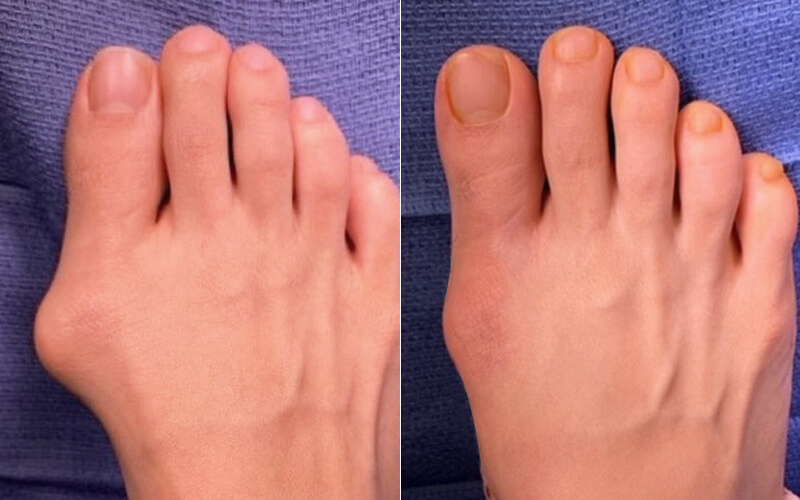Foot Neuroma Surgery (Morton’s Neuroma)
What is Morton’s Neuroma?
Morton’s Neuroma (neurectomy) is a condition that afflicts the nerves on the ball of the foot, usually in the area between your third and forth toes.
The space between the third and fourth toes (i.e. between the heads of the 3rd and 4th metatarsal bones) is most common (at a rate of 90%). Sometimes, the space between the second and third metatarsal bones may be involved. Other locations besides these two points are exceptionally rare. It is very uncommon for Morton’s neuroma to develop on both feet simultaneously in a single patient.
Neuroma refers to a benign (non-cancerous) outgrowth of a nerve. In Morton’s neuroma, an outgrowth develops, most commonly in the space between the third and fourth metatarsal bones. Whatever the origin of the growth, the mechanism by which it causes pain and discomfort is the same.
Due to this growth, the nerve gets trapped between the surrounding bones, tendons, and muscles and causes pain due to the compressive effects by the surrounding structures while the foot is being used.

What Causes Morton’s Neuroma?
The exact mechanism behind the development of Morton’s neuroma is not fully understood. There are certain predisposing factors which can be linked with the development of this condition.
These include:
1. High-Heeled and Uncomfortable Shoes: High heeled shoes and shoes which are narrower around the toescan cause the foot to be in a consistent and compressed state. The nerve as a result gets trapped between the heads of the metatarsal bones and due to this continuous friction and irritation, Morton’s neuroma may develop.
2. Abnormal Foot Shape: Some people have a foot shape that puts more stress on some points on their feet. Examples include people with flat feet, high arches, bunions, exceptionally flexible feet, hammer toes etc. Such people have a high incidence of developing Morton’s neuroma.
3. Athletics: Some athletes may develop neuroma during strenuous exercise and sports because the foot is being constantly affected by pressure and trauma. This may lead to the development of Morton’s neuroma.
4. Post-Traumatic Foot: After a foot trauma, the micro-fractures which go unnoticed usually, may compress on the nerve.
Neuroma’s Surgery (Neurectomy) is Recommended if You Have the Following Symptoms
A neurectomy may be recommended if you exhibit the following symptoms:
1. Pain usually starts after walking for some time, usually associated with wearing an uncomfortable shoe. The pain can be around the ball of the foot radiating to the toes or on the contiguous sides of the two metatarsal bones. It is usually relieved by rest or taking off the uncomfortable shoes.
2. An uncomfortable feeling like there is a pebble beneath the sole of the foot.
3. Burning or tickling sensation in the foot. It may feel like the foot is being electrocuted or you are walking on razors.
4. Numbness in the foot.
These symptoms are relieved by rest and flexing the toes and exacerbated by walking and wearing uncomfortable shoes.
Neuroma Treatment (Neurectomy)
Neurectomy is the best, definitive treatment of Morton’s neuroma. The foot is incised open and the growth on the nerve is removed.
There are two approaches commonly used for neurectomy.
1. Foot is incised and entered from the dorsal surface (the top of the foot). In this approach, to reach the nerve, the deep transverse metatarsal ligament connecting the 3rd and 4th metatarsal bone must be cut. This results in exaggerated postoperative splaying of the 3rd and 4th digits (toes) due to the loss of the supporting ligament (deep transverse metatarsal ligament).
This has aesthetic concerns for some patients. In the long term, it may also have some implications on the general health and support structures of the foot.
2. Foot is incised and entered from the ventral side (the sole of the foot). This procedure can be done without cutting any additional structures as the approach to the nerve is direct. This has better cosmetic outcomes but the postoperative recovery time for this approach is longer than the dorsal one.
Preparing for Your Neurectomy
The surgery for Morton’s neuroma, Neurectomy, is generally performed under general anesthesia.
Before performing any surgery under general anesthesia, tests for anesthesia-fitness are performed. These include the heart function tests, kidney function tests and lung function tests.
A history about any allergies and drugs and alcohol usage will be taken.
For a surgery scheduled in the morning, come to the hospital at 7 am. Don’t eat anything after 2am, you can drink water till 6 am.
For a surgery planned for the afternoon, come to the hospital at 11am. Have a light breakfast at 7am and then don’t eat after that. You may drink water till 9am.
Post-Op Recovery
The gauze bandage will stay on for two weeks after the surgery. You can go home the same day. Try to take as much rest as possible. Keep your foot elevated. You can walk a bit in a special orthopedic shoe (but only do really important tasks like going to the restroom). Whenever you take your foot down, a little swelling on it is normal.
The dressings on the wound will be removed completely by the 22nd day. Keep the scar moisturized and massage the scar. It will help to keep the scar soft.
Your foot will still be a bit swollen. Wear loose fit shoes.
It will take around 6 weeks for you to go to your normal preoperative activity level.
Doctor Follow-Up
Dr. Jam will schedule some follow-up visits after your surgery. But if you feel any of the following symptoms before or after any follow up visits, contact Dr. Jam as soon as possible.
- Increasing pain
- Increasing redness, swelling or oozing around the wound site.
- Fever




